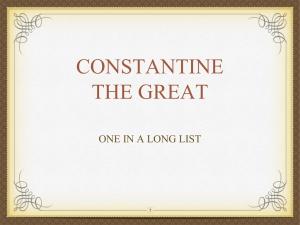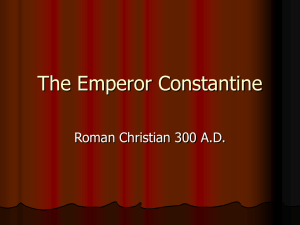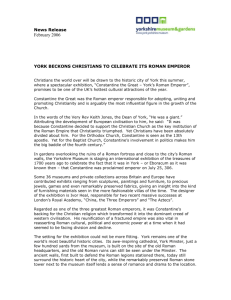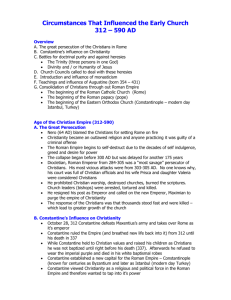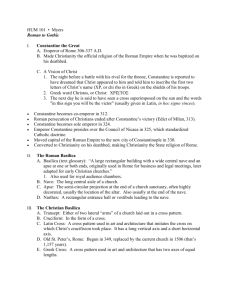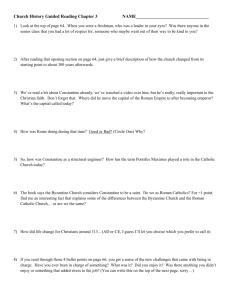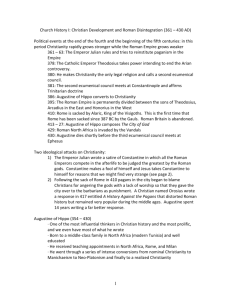CONSTANTINE THE GREAT
advertisement
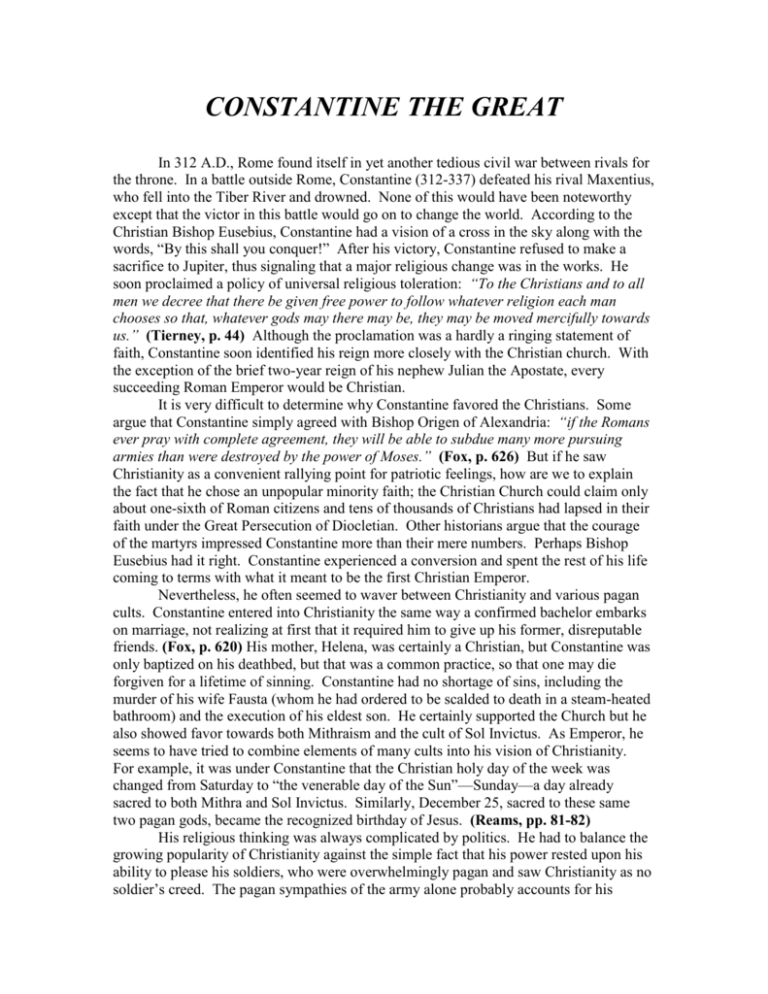
CONSTANTINE THE GREAT In 312 A.D., Rome found itself in yet another tedious civil war between rivals for the throne. In a battle outside Rome, Constantine (312-337) defeated his rival Maxentius, who fell into the Tiber River and drowned. None of this would have been noteworthy except that the victor in this battle would go on to change the world. According to the Christian Bishop Eusebius, Constantine had a vision of a cross in the sky along with the words, “By this shall you conquer!” After his victory, Constantine refused to make a sacrifice to Jupiter, thus signaling that a major religious change was in the works. He soon proclaimed a policy of universal religious toleration: “To the Christians and to all men we decree that there be given free power to follow whatever religion each man chooses so that, whatever gods may there may be, they may be moved mercifully towards us.” (Tierney, p. 44) Although the proclamation was a hardly a ringing statement of faith, Constantine soon identified his reign more closely with the Christian church. With the exception of the brief two-year reign of his nephew Julian the Apostate, every succeeding Roman Emperor would be Christian. It is very difficult to determine why Constantine favored the Christians. Some argue that Constantine simply agreed with Bishop Origen of Alexandria: “if the Romans ever pray with complete agreement, they will be able to subdue many more pursuing armies than were destroyed by the power of Moses.” (Fox, p. 626) But if he saw Christianity as a convenient rallying point for patriotic feelings, how are we to explain the fact that he chose an unpopular minority faith; the Christian Church could claim only about one-sixth of Roman citizens and tens of thousands of Christians had lapsed in their faith under the Great Persecution of Diocletian. Other historians argue that the courage of the martyrs impressed Constantine more than their mere numbers. Perhaps Bishop Eusebius had it right. Constantine experienced a conversion and spent the rest of his life coming to terms with what it meant to be the first Christian Emperor. Nevertheless, he often seemed to waver between Christianity and various pagan cults. Constantine entered into Christianity the same way a confirmed bachelor embarks on marriage, not realizing at first that it required him to give up his former, disreputable friends. (Fox, p. 620) His mother, Helena, was certainly a Christian, but Constantine was only baptized on his deathbed, but that was a common practice, so that one may die forgiven for a lifetime of sinning. Constantine had no shortage of sins, including the murder of his wife Fausta (whom he had ordered to be scalded to death in a steam-heated bathroom) and the execution of his eldest son. He certainly supported the Church but he also showed favor towards both Mithraism and the cult of Sol Invictus. As Emperor, he seems to have tried to combine elements of many cults into his vision of Christianity. For example, it was under Constantine that the Christian holy day of the week was changed from Saturday to “the venerable day of the Sun”—Sunday—a day already sacred to both Mithra and Sol Invictus. Similarly, December 25, sacred to these same two pagan gods, became the recognized birthday of Jesus. (Reams, pp. 81-82) His religious thinking was always complicated by politics. He had to balance the growing popularity of Christianity against the simple fact that his power rested upon his ability to please his soldiers, who were overwhelmingly pagan and saw Christianity as no soldier’s creed. The pagan sympathies of the army alone probably accounts for his 2 inconsistent religious policy in which he stood for Christian unity yet paid lip service to paganism. (Reams, p. 82) Later Constantine identified himself more openly with Christianity, declaring that he was “brought to the faith by God to be the means of the faith’s triumph.” He called on his subjects to convert and he wrote a letter to the King of Persia advising him to convert to Christianity. (Tierney, p. 44) Although he became more and more sarcastic towards the pagan cults, he never took legal measure to abolish them. After 312, Constantine still lived and ruled among an overwhelming pagan majority. His troops were almost all pagans, and so were his ruling class and officials. They drafted his laws and issued his proclamations. Sometimes, but not always, he would insist on the supremacy of Christian formula. At other times, he would let pagan officials address him in non-Christian language; as when his generals greeted him at headquarters with the acclamation: “Constantine, may the immortal gods preserve you for us.” (Fox, p. 622) As he put it in one decree “We do not forbid the services of a bygone age to be conducted in open view.” (Lewis & Reinhold, p. 607) Constantine usually argued that the old policy of persecution pursued by various emperors, was not just cruel, but wasteful: it had brought calamity upon the empire. He liked to point out that God’s vengeance on persecutors was swift and terrible. Here are Constantine’s words to a church council on the fate of previous emperors who persecuted the Christians: (The Oration) To thee, Decius, I now appeal, who has trampled with insult on the labors of the righteous: to thee, the hater of the Church, the punisher of those who lived a holy life: what is now thy condition after death? How hard and wretched thy present circumstances! Nay, the interval before thy death gave proof enough of thy miserable fate, when, overthrown with all thin army, thou didst expose the vaunted power of Rome to the contempt of the Goths. Thou too, Valerian, who didst manifest the same spirit of cruelty towards the servant of God, hast afforded an example of righteous judgment. A captive in the enemies’ hands, led in chains while yet arrayed in the purple and imperial attire, and at last thy skin stripped from thee, and preserved by command of Sapor the Persian king, thou hast left a permanent trophy of thy calamity. (Brophy, p. 279) An Unlikely Partnership Constantine went beyond toleration; he gave the Church new “liberties.” Liberty, in the medieval sense of that term, means freedom from obligation. He exempted the clergy of the Catholic Church from the burden of civic office. This was an enormous change in state policy because, since the days of Ancient Greece, only favored members of society such as athletes, “exceptional sophists”, and veterans had enjoyed such favor. Constantine argued that the clergy, through their prayers, already worked for the safety and prosperity of everyone. In other words, Constantine officially dropped the old Roman accusation that Christians make poor citizens. He recognized for the first time the Christian position, which held, in the words of Origen: “If Christians do avoid the responsibilities of civic office, it is not because they want to avoid public service. The keep themselves for a more divine and necessary service in the Church of God for the salvation of all.” (Fox, p. 623) 3 As the favored religion of the empire, the Christian church received other special privileges from the state. It was given the right to receive legacies—and extremely important privilege for any corporation. Its clergy was exempted from taxation. Under the pagan empire, the Christians usually tried to avoid the imperial courts and settled their disputes by arbitration of the local bishop. Constantine now allowed bishops to act as judges in all legal disputes in which a Christian was party. In short, the church became a privileged corporation enjoying significant rights and some governmental power. The church created a complex administrative system that mirrored the organization of the imperial civil administration. For example, an ecclesiastical map of France in the Middle Ages accurately shows the old Roman provincial organization. After Constantine, the Roman Catholic Church was just that: the Church of Rome. There was no recognized leader of the church, aside from the emperor. The bishops of Alexandria, Rome, Jerusalem, and Antioch, all claimed special prestige by their connection to the original apostles sent out by Jesus. The bishop of Rome claimed the right of seniority the first bishop had been the Apostle Peter and because Rome was the ancient capital of the empire. (Tierney, p. 44) Constantine abolished the Roman practice of crucifixion and banned infanticide. He and his successors built great churches at imperial expense, including the Church of the Nativity in Bethlehem. Constantine also boasted of the special harness for his horse incorporating nails from the true cross. (Grant, p. 203) In Rome itself, the Senate honored Constantine with an enormous statue, holding a “lofty spear in the shape of the cross.” This huge monument, “ten times larger than life” stood in a basilica built for secular purposes—i.e. courts of law. The wave of church construction, at imperial expense, amounted to propaganda in stone. (Fox, p. 623) The gladiatorial games declined and Constantine built great new facilities in Rome and new city of Constantinople for the less bloody sport of chariot racing. Slavery continued for the Roman economy could not survive without slaves, but the church encouraged Christians to free their slaves. Citing the will of God, Constantine banned the old Roman practice of branding slaves on the face. Hundreds of thousands of new converts poured into the church. At the beginning of the 4th Century, Christianity was still a minority church; by the end of the century, Christianity was a world religion claiming at least 50% of all Roman citizens as well as many Germanic people outside the imperial borders. (Holister, p. 17) The conversion of Constantine obviously brought new opportunities to the church but it also created an enormous new problem—one that has persisted in Western history to the present day—the problem of church and state. As Emperor, Constantine chose to follow the example of Diocletian and rule as an absolute monarch. This meant that state favor for the church came at a high price. The church lost a portion of its independence. Constantine made himself the champion of the church, but expected in return that bishops would conduct themselves as loyal servants of the emperor. As a Christian, the Emperor could no longer claim to be divine like the old pagan emperors, but many churchmen were willing to grant him a status that was almost godlike. To Eusebius, Bishop of Caesaria, Constantine was the 13th Apostle; God commissioned his office; his status put him above the church. Churchmen spoke of his divine face; as was the case with Diocletian, the word “sacred” was applied to the Emperor’s person, family, and decrees. 4 Constantine might claim the right to defend the true faith, but this implied that he as emperor, would determine what constituted orthodox faith. He claimed to be “the servant of God” answerable for the conduct of his Christian subjects. He asserted his genuine fear of God’s wrath against his person if he failed to preside over Christian concord in the Church. (Fox, p. 625) In other words, it was difficult for the church to set any limit to “things that are Caesar’s when Caesar had made himself the foremost friend of Christianity. Constantine might be Christian, but he was also Roman. In the Roman tradition, religion—any religion—was always considered in a subordinate position to the needs of the state. He told the bishops, “You are bishops within the church. But I have been appointed by God as bishop of what lies outside the church.” (Grant, p. 182) As we have seen, the Roman state played an important role in determining the relationship of the early church to Judaism; in practical terms, Constantine would play a significant role in determining the form and doctrines of orthodox Christianity. (Tierney, p. 45) Christian Heresies of the 4th Century During the centuries when the church faced hostility and persecution from the Roman state, Christians had concentrated on those things that united them in the faith. “As long as Christians had been part of an alternative society, their shrines were harbors in a world ruled by demonic powers. But now the alternative to society had become the society. Their shrines now became arenas in which battles among Christians could be fought out.” (Eugen Weber) It was no simple problem to determine what true Christian doctrine should be. The denominations of the modern world may cooperate with one another and urge the ecumenical spirit, but each is likely to claim that their interpretation of scripture and doctrine is correct. One controversy had its origins in the state persecutions ordered by Diocletian. Tens of thousands of Christians had denied the faith under threat of death and now they wished to return to the fold. Most bishops forgave them and welcomed them back, but one bishop in North Africa, Donatus, would not reinstate priests and deacons who had lapsed into their old offices. The real issue was cultural as much as theological. The Donatists were Christians, in the words of Michael Grant, who “completely spurned traditional, classical culture, and rejected the sovereignty of Constantine’s official church which they identified with this hated background.” (Grant, p. 165) In strict theological terms, Bishop Donatus, like Christian reformers all the way down to Martin Luther, argued that the validity of a sacrament depended upon the moral worthiness of the priest conducting the service. Other churchmen, including St. Augustine argued that any consecrated official of the church was a valid minister of the sacraments—whatever his personal failings. In other words, it was the church, not the individual that counted. Constantine called a general church council to settle the issue. The emperor didn’t really care about the theological or moral niceties involved in the controversy, but he regarded the Donatists as troublemakers and schismatics—i.e. people who would destroy the unity of the imperial church if not stopped. Above all, he wanted religious unity. When the Donatists refused to accept the verdict of his theological advisors, he employed force to remove some Donatist clergy. Donatism became the first officially condemned heresy. The idea that orthodoxy should be enforced by the secular power and that heresy represented both a political and spiritual 5 danger would become an entrenched aspect of medieval Christianity. Constantine regarded orthodox Christian doctrine as an important political tool; how could the church save the Roman Empire if Christians were constantly squabbling over theology? Even more importantly, Constantine believed that religious discord gave the pagans good cause to ridicule the Christians. As he put it in a letter: “That the Catholic Church should be free of dissension is surely in accordance with the prosperity of these times. Yet some have overcome by a passion for unhealthy quarreling. They are trying to cause confusion, and confusion is, in my opinion, the worst of all calamities.” (Grant, p. 162) Arianism A far more important controversy was brewing in Egypt over the essential nature of Jesus Christ. “Is Christ a man who becomes God?” Is he a God who temporarily becomes a man? Is he a God who is God and Man at the same? Is he equal to God the Father, or subordinate, as a good son should be? This may sound like hairsplitting, but a lot of blood was shed and a lot of people suffered for each of these views. Rival doctrines also became associated with this region or that; they became part of what we might call a national or tribal identity. For example, the city of Constantinople stood for a Christian God who combines two natures in one; Alexandria stood one nature only. From then on, when one province or people or political party fought one another, it would often be as orthodox versus heretic on behalf of one doctrine or another.” (Eugen Weber) Arius, a priest in the church at Alexandria, argued that Christ was of a similar substance and being as God, but not the same. In other words, Christ was a creation of God—the highest of God’s creatures, but still a man. Another Alexandrian churchman, Athanasius, argued the opposite point of view. Athanasius insisted that God and Christ were of one and the same substance and being, and therefore equal in their divinity. (Adams, p. 116) The issue might seem esoteric and incomprehensible to a modern secular humanist, but the controversy went directly to the essence of Christian theology: Was Jesus Christ fully divine? There was another issue at stake as well: Should the church attempt to reconcile Christian teachings with pagan reason and philosophy? Arianism can be seen as a reversion to the old Homeric Greek view that humans can aspire to divinity—that there can be an intermediate position between heaven and earth. Athanasius insisted that the Arians were attacking the man’s potential deification and salvation. “How shall man be changed into God unless God has been changed into man? (Parkes, p. 442) In 325, Constantine ordered a general conference of the church convened to settle the dispute. By issuing a general invitation to all bishops and providing state transport, the emperor created the supreme Catholic institution of church government, the general council. The Council of Nicaea, over 250 bishops, met and wrangled for weeks over the controversy. Bishop Eusebius described the entrance of Constantine as: dazzling the eyes of all with the splendor of his purple robe and sparkling with fiery rays, adorned for the occasion as he was with an extraordinary splendor of gold and jewels. As for his soul, it was sufficiently apparent that he was adorned with the fear of God and religion. (Lewis&Reinhold, p. 610) 6 The Emperor was probably more persuaded by the Arian position, but ultimately he chose a simple way out: he counted noses. There were more Athanasians in the Council, so Arianism became a heresy. The Council produced a document known as the Nicean Creed: “We believe in one God the Father All-sovereign, maker of all things visible and invisible; And in one Lord Jesus Christ, the Son of God, begotten of the Father, only-begotten, that is, of the same substance of the Father, God of God, Light of Light, true God of true God, begotten not made, of one substance with the Father…. (Spielvogel, p. 202) Many historians regard this image of Emperor Constantine, seated among his bishops, debating the nature of the Christian Trinity, as the real beginning of the Middle Ages. It is hard to imagine a greater contrast to Caesar Augustus! Constantine wanted an established church, to which all good Christians would belong; and those who would not belong to it were dismissed as “heretics”—a term resounding with mutual Christian accusations, and with a long and ominous history ahead of it. The Donatists and the Arians would be the first unfortunate heretics to experience a new form of persecution at the hands of a Christian emperor—the first of a long line of heretics to face the various inquisitions of orthodox Catholicism. In time, he believed all pagan and heretics would see the folly of their ways. It is probably wrong to ascribe the inquisitions and burnings at the stake we see in medieval Catholicism to Constantine. He was still enough of a Roman to find the idea of coercion to orthodox belief to be hateful. “It is one thing to undertake the contest for immortality voluntarily,” he wrote, “another to compel others to do likewise through fear of punishment.” (Fox, p. 637) Constantine, by his conversion, changed the world. For centuries Christians pretended that the state was irrelevant and the pagans pretended that Christians were irrelevant. Constantine bridged the gap and brought religious and civil society together. It would be a troubled marriage, as it often is today. Historians still question his understanding of the faith. Constantine’s version of Christianity seems almost alien to modern Christians. The God he believed in was a God of power, who had given him victory, established him and his family as the tools of God’s will, and thereby led the way towards a great restoration of Roman power. He had little understanding or sympathy with the view that Christianity also meant love, charity, and humility. Theological disputes ought to be avoided along with any activities that might lead to dissension and disobedience to God’s deputy the Emperor. If Constantine brought church and state together for the first time in European history, the church gained the most from this unlikely partnership because it inherited all the charisma of Rome; the empire gained less. In fact, the Roman Empire in the west outlived Constantine by a mere 139 years. Nevertheless, it is impossible to avoid the conclusion that Constantine played a remarkable role in the creation of Christianity as a world religion. He deserves to be remembered as the most significant figure in the growth of the church since Paul of Tarsus. In the words of the British historian J.M. Roberts, Constantine “registered a decisive break with the tradition of classical Rome. Ultimately, he founded Christian Europe and, therefore, the modern world.” (Roberts, p. 278) 7 Constantinople Another decision, only slightly less important than his personal conversion, was his foundation, “on command of God”, he said, of the new Christian capital to rival pagan Rome, at the entrance of the Black Sea. He modestly named his new capital “the city of Constantine” or Constantinople. It would be the first major Christian city and it would set the model for Christian architecture. The great church of the Holy Wisdom, “Hagia Sophia”—now a mosque, was the greatest church in Christendom. Like Rome, the new city was built with all the trappings of classical urban civilization: a Forum, an arena or hippodrome for the great chariot races, which would replace gladiatorial combats, arenas, and theaters for drama and comedy. Constantinople had a senate and its people received the same shares of grain from the Imperial grain fleet as the people of Rome did. If Constantinople was free of pagan traditions, it was also free of those irritating Roman republican traditions too. Constantine, according to Eusebius, “said that people tainted by original sin could hardly expect political freedom.” By moving his capital to the east, Constantine helped to create the political map of the Middle Ages: a Latin-speaking Europe and a Greek-speaking East. The final component would be the emergence of the Islamic world.
